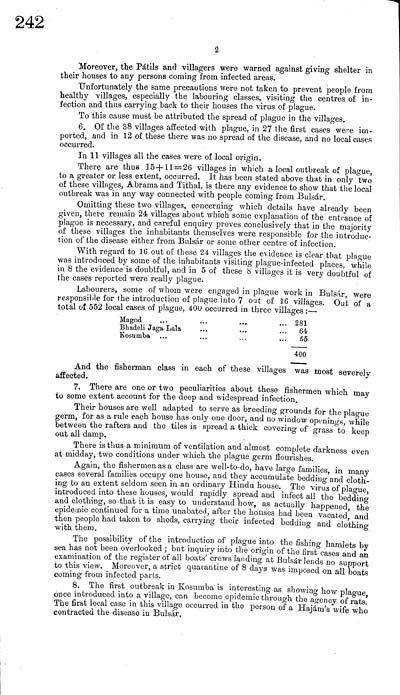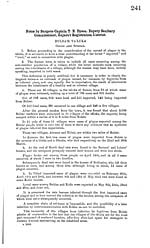Medicine - Disease > Account of plague administration in the Bombay Presidency from September 1896 till May 1897
(256) Page 242
Download files
Individual page:
Thumbnail gallery: Grid view | List view

2
Moreover, the Ptils and villagers were warned against giving shelter in
their houses to any persons coming from infected areas.
Unfortunately the same precautions were not taken to prevent people from
healthy villages, especially the labouring classes, visiting the centres of in-
fection and thus carrying back to their houses the virus of plague.
To this cause must be attributed the spread of plague in the villages.
6. Of the 38 villages affected with plague, in 27 the first cases were im-
ported, and in 12 of these there was no spread of the disease, and no local cases
occurred.
In 11 villages all the cases were of local origin.
There are thus 15 + 11 = 26 villages in which a local outbreak of plague,
to a greater or less extent, occurred. It has been stated above that in only two
of these villages, Abrama and Tithal, is there any evidence to show that the local
outbreak was in any way connected with people coming from Bulsr.
Omitting these two villages, concerning which details have already been
given, there remain 24 villages about which some explanation of the entrance of
plague is necessary, and careful enquiry proves conclusively that in the majority
of these villages the inhabitants themselves were responsible for the introduc-
tion of the disease either from Bulsr or some other centre of infection.
With regard to 16 out of these 24 villages the evidence is clear that plague
was introduced by some of the inhabitants visiting plague-infected places, while
in 8 the evidence is doubtful, and in 5 of these 8 villages it is very doubtful of
the cases reported were really plague.
Labourers, some of whom were engaged in plague work in Bulsr, were
responsible for the introduction of plague into 7 out of 16 villages. Out of a
total of 552 local cases of plague, 400 occurred in three villages:-
Magod ... ... ... 281
Bhadeli Jaga Lala ... ... ... 64
Kosumba ... ... ... 55
---
400
---
And the fisherman class in each of these villages was most severely
affected.
7. There are one or two peculiarities about these fishermen which may
to some extent account for the deep and widespread infection.
Their houses are well adapted to serve as breeding grounds for the plague
germ, for as a rule each house has only one door, and no window openings, while
between the rafters and the tiles is spread a thick covering of grass to keep
out all damp.
There is thus a minimum of ventilation and almost complete darkness even
at midday, two conditions under which the plague germ flourishes.
Again, the fishermen as a class are well-to-do, have large families, in many
cases several families occupy one house, and they accumulate bedding and cloth-
ing to an extent seldom seen in an ordinary Hindu house. The virus of plague,
introduced into these houses, would rapidly spread and infect all the bedding
and clothing, so that it is easy to understand how, as actually happened, the
epidemic continued for a time unabated, after the houses had been vacated and
then people had taken to sheds, carrying their infected bedding and clothing
with them.
The possibility of the introduction of plague into the fishing hamlets by
sea has not been overlooked; but inquiry into the origin of the first cases and an
examination of the register of all boats' crews landing at Bulsr lends no support
to this view. Moreover, a strict quarantine of 8 days was imposed on all boats
coming from infected parts.
8. The first outbreak in Kosumba is interesting as showing how plague,
once introduced into a village, can become epidemic through the agency of rats.
The first local case in this village occurred in the person of a Hajm's wife who
contracted the disease in Bulsr.
Moreover, the Ptils and villagers were warned against giving shelter in
their houses to any persons coming from infected areas.
Unfortunately the same precautions were not taken to prevent people from
healthy villages, especially the labouring classes, visiting the centres of in-
fection and thus carrying back to their houses the virus of plague.
To this cause must be attributed the spread of plague in the villages.
6. Of the 38 villages affected with plague, in 27 the first cases were im-
ported, and in 12 of these there was no spread of the disease, and no local cases
occurred.
In 11 villages all the cases were of local origin.
There are thus 15 + 11 = 26 villages in which a local outbreak of plague,
to a greater or less extent, occurred. It has been stated above that in only two
of these villages, Abrama and Tithal, is there any evidence to show that the local
outbreak was in any way connected with people coming from Bulsr.
Omitting these two villages, concerning which details have already been
given, there remain 24 villages about which some explanation of the entrance of
plague is necessary, and careful enquiry proves conclusively that in the majority
of these villages the inhabitants themselves were responsible for the introduc-
tion of the disease either from Bulsr or some other centre of infection.
With regard to 16 out of these 24 villages the evidence is clear that plague
was introduced by some of the inhabitants visiting plague-infected places, while
in 8 the evidence is doubtful, and in 5 of these 8 villages it is very doubtful of
the cases reported were really plague.
Labourers, some of whom were engaged in plague work in Bulsr, were
responsible for the introduction of plague into 7 out of 16 villages. Out of a
total of 552 local cases of plague, 400 occurred in three villages:-
Magod ... ... ... 281
Bhadeli Jaga Lala ... ... ... 64
Kosumba ... ... ... 55
---
400
---
And the fisherman class in each of these villages was most severely
affected.
7. There are one or two peculiarities about these fishermen which may
to some extent account for the deep and widespread infection.
Their houses are well adapted to serve as breeding grounds for the plague
germ, for as a rule each house has only one door, and no window openings, while
between the rafters and the tiles is spread a thick covering of grass to keep
out all damp.
There is thus a minimum of ventilation and almost complete darkness even
at midday, two conditions under which the plague germ flourishes.
Again, the fishermen as a class are well-to-do, have large families, in many
cases several families occupy one house, and they accumulate bedding and cloth-
ing to an extent seldom seen in an ordinary Hindu house. The virus of plague,
introduced into these houses, would rapidly spread and infect all the bedding
and clothing, so that it is easy to understand how, as actually happened, the
epidemic continued for a time unabated, after the houses had been vacated and
then people had taken to sheds, carrying their infected bedding and clothing
with them.
The possibility of the introduction of plague into the fishing hamlets by
sea has not been overlooked; but inquiry into the origin of the first cases and an
examination of the register of all boats' crews landing at Bulsr lends no support
to this view. Moreover, a strict quarantine of 8 days was imposed on all boats
coming from infected parts.
8. The first outbreak in Kosumba is interesting as showing how plague,
once introduced into a village, can become epidemic through the agency of rats.
The first local case in this village occurred in the person of a Hajm's wife who
contracted the disease in Bulsr.
Set display mode to: Large image | Zoom image | Transcription
Images and transcriptions on this page, including medium image downloads, may be used under the Creative Commons Attribution 4.0 International Licence unless otherwise stated. ![]()
| India Papers > Medicine - Disease > Account of plague administration in the Bombay Presidency from September 1896 till May 1897 > (256) Page 242 |
|---|
| Permanent URL | https://digital.nls.uk/74517522 |
|---|




